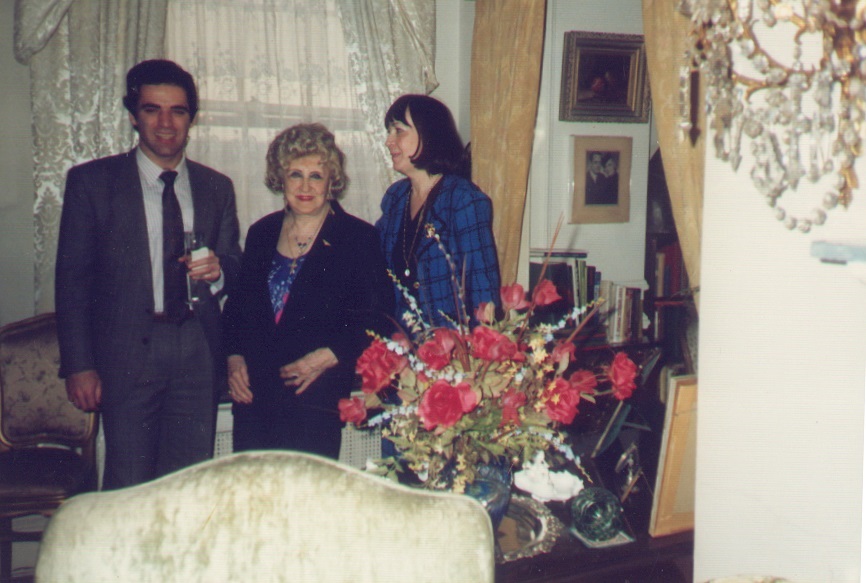
Edward Winter
As reported in C.N. 3002, on 11 April 1988 Olga Capablanca sent us this photograph of her with Kasparov which had been taken in New York earlier that year ‘at the small reception I gave in my apartment’:

The present general article on Garry Kasparov complements the following more specific feature articles:
Kasparov, Karpov and the Scotch
Kasparov’s Child of Change
The Termination
Kasparov v Miles, Basle, 1986
The 1986 FIDE Presidential Election
Garry Kasparov and New Chronology
Kasparov and his Predecessors
Kasparov Interviews
Reflections on Garry Kasparov
The ‘Garry Kaspartov’ Scam
Kasparov’s How Life Imitates Chess
Books about Fischer and Kasparov
Three photographs from our archives (presented in C.N.s 9325, 9787 and 9823 respectively):


Boris Spassky, Garry Kasparov, Páll Magnússon, Victor Korchnoi (Reykjavik, 1988).

The Baku genius being firmly burdened with the tag ‘future world champion’, Batsford have found it opportune to bring out Fighting Chess, My Games and Career ‘by Gary Kasparov’. Kasparov annotates about half of the 64 games, some just well but some outstandingly. The quality of the games, with their emphasis on combinative strokes which are frequently staggering, is all that one would expect; this book immediately takes its place as the prime source on Kasparov’s short life so far and is warmly recommended.
Warmly recommended despite its faults. The back-cover blurb goes well over the top and back again (Kasparov is ‘perhaps the most exciting chessplayer of all time’, etc. etc.) It was astonishing to read such a confusing and badly written Preface above the name of Robert G. Wade, but the remainder of his contribution to the book is excellent – and extensive. In fact it is so extensive that Kasparov should not have been credited with sole authorship; ‘by Gary Kasparov and Robert G. Wade’ would have been more truthful, if less commercially beneficial.
Batsford merit severe censure for the way they are pushing Kasparov’ s name on book covers irrespective of his real role. And, in case anyone should interpret this criticism as dubious, we must quote Eric Schiller on page 91: ‘Kasparov is about to set another record. He has prepared a manuscript (in collaboration with his trainer Nikitin) on the Sicilian Scheveningen, to be published shortly. This must make him one of the youngest chess authors ever!’ So the implication is clear: Schiller, who was deeply involved himself in both BCO and Fighting Chess, does not consider Kasparov the author of either.
(507)
The Test of Time by G. Kasparov, translated by K.P. Neat (Pergamon Press) ... turns out to be a top-notch book, fully worthy of a world champion. It is rare indeed for everything (games, annotations, translation, production) to come right in a single book but The Test of Time is definitely that exceptional work. The apparent innovation of giving annotational second thoughts in a clearly distinguishable way deserves to be copied, but will it be? Such a search for chess truth makes great demands on the annotator.
... The depth and beauty of Kasparov’s writing in The Test of Time may be contrasted with the way others write up his games. One instance will suffice: On page 101 of the July 1985 CHESS (Kasparov-Hübner, second match-game) the latter’s 14th move is criticized, apparently on the basis of what Raymond Keene wrote of 14...Qd8 in The Spectator of 15 June 1985: ‘An inexplicable retreat. Why not 14...a5 at once?’ However, Kasparov subsequently annotated the game in the August 1985 New In Chess. He dismissed 14...a5 because of 15 bxa5 Rxa5 16 Rxb6, and called 14...Qd8! ‘an excellent positional idea’. Kasparov said that Black’s fatal errors were his 27th and 30th moves. Both of these are passed over without comment by CHESS and The Spectator. And did the passion for truth lead those two magazines to print corrections? Of course not.
(1145)
Another example of B.H. Wood’s increasingly peculiar judgement, from a letter to us dated 11 September 1986:
‘I just noticed C.N. 1145. I certainly would never claim 100% accuracy over any annotation even one by Kasparov however high a percentage he would attain. He even committed one inaccuracy in an earlier world championship game which was noticed with surprise by practically 95% of the spectators.’
What precisely is Mr Wood saying? Does he mean that he examined and rejected Kasparov’s view on that Hübner move? If so, why didn’t readers deserve to be told Mr Wood’s reasons, or at least be informed that Kasparov’s opinion differed from that of CHESS? Did he overlook the Kasparov note in New in Chess? Or did he simply not want to give publicity to a Dutch rival magazine of such marked superiority?
Mr Wood’s statement ‘I certainly would never claim 100% accuracy over any annotation’ is plainly untrue. As recently as in the June 1986 issue of CHESS (page 128) there was the following editorial comment:
‘If you find any move hard to understand, STOP and investigate. It will not be an error: this analysis is of top quality.’
(1282)
A major controversy in Harry Golombek’s journalistic career:
‘Harry Golombek suspects a sinister plot behind the disastrous performance of the challenger in the world championship’
Golombek strongly criticized the performance of both players, and the key (speculative) passage was:
‘Perhaps Kasparov has been warned not to play well and has been given to understand that the consequences for him and his family would be disastrous if he did.’

‘What my critics fail to explain is why Kasparov is playing in a style totally unprecedented for him in which he embarks on attacks without due preparation – a procedure which he has never before adopted. They also fail to explain why he is adopting lines of play and openings which are fimiliar [sic] to Karpov and not at all the type of opening he himself has played before.’
There was also this paragraph:
‘Mr Golombek pointed out yesterday that the results to date were entirely out of keeping with the normally accurate Elo rating system of classifying the strength of champions. The most recent assessments of Karpov and Kasparov had indicated a match win by the challanger [sic] of about six games to four, he added.’
A letter to The Times from [‘Señor’] Campomanes was also cited:
‘Any suggestion that either player is being driven by external pressures into consciously substandard play is absured [sic] and ridiculous. The reality is that Karpov, the world champion, is producing chess of a very high standard, and his challenger, Kasparov, though less a [sic] successful hitherto, has fought and give [sic] of his best.’
The final paragraph added that Golombek’s arguments had also been rejected by members of Kasparov’s delegation.
For Kasparov’s comments on the controversy, see pages 115-116 of ‘Garry Kasparov on Modern Chess Part Two Kasparov vs Karpov 1975-1985 including the 1st and 2nd matches’ (London, 2008).
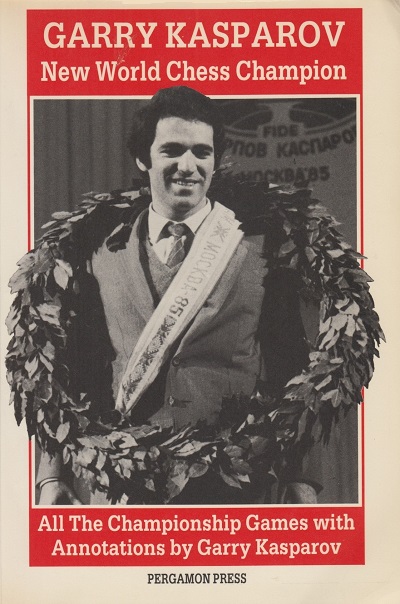
Illustrated with 25 ‘plates’ with rather babyish captions, Garry Kasparov’s New World Chess Champion (Oxford, 1986) has annotations to all 24 games of the second K-K match. There is a regrettably, but predictably, slanted Foreword on the termination of the earlier contest. Can he really be unaware of all the new evidence which has emerged since the Anything Goes period (roughly February 1985-mid January 1986) when he and his myrmidons had the argument all their own way? We doubt whether this book will be remembered as a great one, as will, probably, The Test of Time, although the annotations are obviously the best the match games have had. It may have been difficult for Kasparov to write such a work at a time when he knew he was about to re-encounter Karpov.
(1231)
As reported in C.N. 1342, A.J. Gillam (Nottingham, England) wrote to us as follows on 13 January 1987:
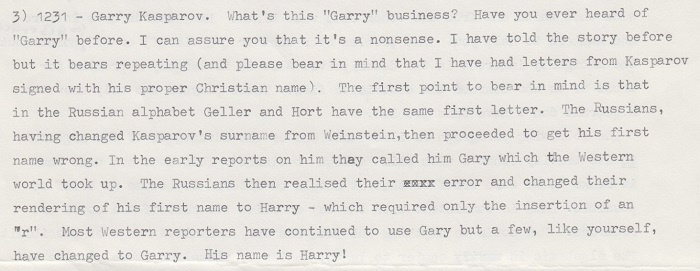
Although Tony Gillam protested in C.N. 1342 about our use of ‘Garry’ Kasparov, that is the spelling in his new autobiography (Child of Change – title page and, e.g., page 27). From this book (page 24):
‘People are puzzled that I changed my name from Weinstein to Kasparov around the age of 11 and assume this was to disguise my Jewish background. This is quite wrong. In any event, taking an Armenian name was simply exchanging one minority for another. It made no difference politically. The reason was that I had gone to live with my mother’s family, the Kasparovs, from the time my father first became ill and it seemed more natural to use their name ...
It is not clear why I was called Garik. My father took a great interest in names, but on this occasion he could not decide, so I had no name at all for two months. When his brother was born, 14 years my father’s junior, he had happened to be reading Spartacus and suggested Leonidas. What book he was reading when I was born we never discovered. At home in Baku most people pronounce my name “Harry” because of the soft Russian “G” sound.’
(1473)
On page 11 of the December 1987 news flash the Editor, R.G. Wade, writes a brief notice of C.N. From this we quote:
‘... when B.T. Batsford decided to publish Fighting Chess with Mr Kasparov as its subject and a principal author, we asked him during the Luzern Olympiad (1982) how we should present his first name. Should it be Gary/ Garry/ Gari/ Garri/ Hari/ Harry? Mr Kasparov asked us to use Gary.’
(1527)
C.N. 10433 (see below) quoted from page 269 of Deep Thinking by Garry Kasparov with Mig Greengard (New York, 2017):
‘Publications deciding on the English spelling of my first name used to fluctuate between Gary, Garry and even Garri, but I prefer Garry.’
Addition on 8 June 2023:
From pages 45-46 of Garry Kasparov on Garry Kasparov Part I: 1973-1985 (London, 2011):
‘This tournament [the Spartakiad Team Championship, 1975] was the last in which I played under the surname Weinstein. In August 1975, at a family council of the Weinsteins and Kasparovs, it was decided that I should take the surname of my mother, which she had not changed when she married. It seemed natural to become a Kasparov: for nearly five years I had been brought up in my mother’s family, and had grown up under the care of my grandfather Shagen, who had no sons. But the real implication of what happened was revealed to me much later.
Nikitin: “Changing surname is a delicate process. While normal with women, it very rarely occurs with men and only, as a rule, when it is obligatory. The main burden in the fight to carry out the juridical formalities and, more important, to convince all the relatives and friends of the correctness of the decision, fell on Garik’s mother. How many unpleasant hours Klara had to endure, how many tears were shed ... A year before that, with Botvinnik’s agreement, I began insistently trying to convince her of the need to change her son’s surname. I had no doubts about the boy’s brilliant chess future. From my work in the USSR Sports Committee I knew what inexplicable problems, not at all to do with chess, could suddenly be encountered by a youth with an ‘incorrect’ surname, and how his sports career could be imperceptibly hindered or even altogether ruined. My fears were justified: much has been written about the latent anti-Semitism, especially in the upper echelons of Soviet power. (I should remind you: in those times diplomatic relations with Israel were broken off and there was a mass emigration of Jews from the USSR – G.K.) I am convinced that Garry Weinstein would not have got through to a world championship match with Anatoly Karpov either in 1984, or in 1987. They would not have allowed it. He would have been eliminated at the distant approaches. At that time the system worked meticulously.”
When in 1989, as three-times world champion and winner of the World Cup, I overtook Fischer’s old rating record and reached the 2800 mark for the first time in history, Tal made one of his unforgettable jokes: “Garry is playing so well, that now he can calmly perform under his previous surname!”
I carefully carried the memory of my father through all the turbulent years, and I am absolutely sure that the Garry Kasparov, who became leader of the chess world, professed the same values as Garik Weinstein, who once, following the example of his father, became fascinated by chess ...
In October 1975, appearing for the first time under the surname Kasparov, I also achieved my first success among adults: in Baku I won the “City Cup”, a knock-out tournament with a shortened time control – an hour each for the entire game.’
C.N. 1348 quoted a remark by Kasparov in the Sunday Times magazine of 10 August 1986, page 50:
Some further quotes from that feature, ‘A Life in the Day of Garry Kasparov’, in which the world champion spoke to Robin Stacey:
The 3/1987 issue of New in Chess (pages 5-6) published an exchange of correspondence between Kasparov and Karpov. A general argument expressed by the former deserves unreserved support:
‘I also think that it is a chessplayer’s duty to update his older analyses and notes from time to time. This is necessary as it should not be permitted in any manner that the text or analyses contain obvious technical anachronisms or mistakes, as a consequence of the rapid development of theory and practice. Moreover, a reprint or a revised edition of a book can and should reflect the changes in the author’s chess ideology caused by his experience over the years. Neglecting these factors in my view reduces the significance of such books and curbs the development of chess.’
(1391)
Tim Krabbé (Amsterdam) sends us the following game from a simultaneous exhibition (+29 –0 =1):
Garry Kasparov – Tim Krabbé
Amsterdam, 28 April 1987
Queen’s Gambit Declined
1 d4 d5 2 c4 c6 3 Nf3 Nf6 4 Nc3 e6 5 Qb3 Nbd7 6 Bg5 Be7 7 e3 O-O 8 Bd3 dxc4 9 Bxc4 b5 10 Be2 a6 11 O-O c5 12 Rfd1 Qc7 13 Bf4 Qb6 14 a4 b4 15 a5 Qa7 16 Na4 Nd5 17 Bg3 cxd4 18 Nxd4 Nc5 19 Nxc5 Bxc5 20 Nc6 Qb7 21 Ne5 Qe7 22 Nd3 f5 23 Nxc5 Qxc5 24 Rac1 Qxa5 25 Rc6 Re8 26 Bh5 g6 27 Bf3 Qb5 28 Rxd5 exd5 29 Bxd5+ Kh8 30 Rc7 Qe2 31 h3 Rb8 32 Bc4 Qe1+ 33 Kh2 f4 34 Bxf4 Qxf2
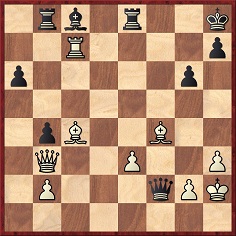
35 Qd3 Qxb2 36 Qd5 Qf6 37 Bg5 Qb2 38 Rxh7+ Resigns.
Our correspondent comments:
‘He absolutely thrashed me, and I’m rated at 2300!’
(1458)
The item was picked up by the 2/1988 New in Chess (page 5).
In December 1997 Michael Lorenz contributed an item to the Chess Café which stated that 35 Bg8 would have won outright and that, rather than 38 Rxh7+, 38 Qf7 would have mated in five. The Chess Café also gave Tim Krabbé’s confirmatory response:
‘In fact, both sacrifice and resignation are nonsense. After 38…Kxh7 39 Qf7+ Qg7 40 Qxe8 Qc7+ (40…b3 or a5 41 Qe4) 41 Bf4 Qxc4 42 Be5 Be6 43 Qxb8 Qc8 44 Qxb4 White will have to work to win, if there is a win at all.’
(2186)
An addition on page 289 of Kings, Commoners and Knaves from Douglas Bryson was that the Fritz computer program pointed out that 34 Bh4 mates in six moves.
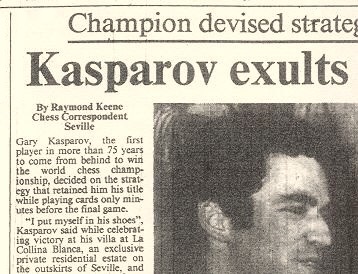
On page 2 of The Times of 21 December 1987 Raymond Keene claimed that Kasparov is ‘the first player in more than 75 years to come from behind to win the world chess championship’.
What about the title matches played in 1927, 1935, 1937, 1951, 1954, 1957, 1963, 1969, 1972 and 1985?
(1582)
In 1989 Garry Kasparov offered some comments on chess computers in an interview with Thierry Paunin on pages 4-5 of issue 55 of Jeux & Stratégie (our translation from the French):
‘Question: ... Two top grandmasters have gone down to chess computers: Portisch against “Leonardo” and Larsen against “Deep Thought”. It is well known that you have strong views on this subject. Will a computer be world champion, one day ...?
Kasparov: Ridiculous! A machine will always remain a machine, that is to say a tool to help the player work and prepare. Never shall I be beaten by a machine! Never will a program be invented which surpasses human intelligence. And when I say intelligence, I also mean intuition and imagination. Can you see a machine writing a novel or poetry? Better still, can you imagine a machine conducting this interview instead of you? With me replying to its questions?’
(1802)
See Chess and Computers.
The loser of the following game has submitted the score to us:
Garry Kasparov (simultaneous) – Harald E. Balló
Cologne, 29 October 1988
Queen’s Indian Defence
1 d4 Nf6 2 c4 e6 3 g3 c5 4 Nf3 b6 5 Bg2 Bb7 6 d5 exd5 7 Nh4 g6 8 Nc3 Bg7 9 O-O O-O 10 Bg5 h6
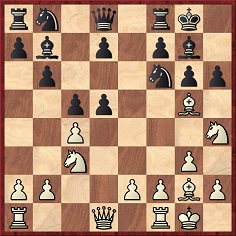
11 Bxf6 Bxf6 12 Nxg6 Bxc3 13 bxc3 Re8 14 Nf4 Nc6 15 Bxd5 Qg5 16 e4 Rad8 17 Nd3 Na5 18 f4 Qg7 19 e5 Ba6 20 Qa4 d6 21 Rae1 dxe5 22 Nxe5 Re7 23 Nxf7 Rxf7 24 Re8+ Rxe8 25 Qxe8+ Qf8 26 Bxf7+ Kg7 27 Qxf8+ Kxf8 28 Bd5 Nxc4 29 Re1 Na3 30 Re6 Bd3 31 Rxh6 Nb5 32 c4 Nc3 33 Kf2 Kg7 34 Rc6 Nxa2 35 Rc7+ Kf6 36 g4 Kg6 37 h4 Nb4 38 h5+ Kh6 39 Kg3 Nxd5 40 cxd5 Resigns.
The position in the diagram arose in Capablanca v Marshall, Carlsbad, 1929, which continued 11 Nxd5. The tournament book points out that List-Sämisch, Berlin, 1927, had proceeded 11 Bxf6 Bxf6 12 Nxg6. Analysis of this line also appeared on pages 40-45 of Tartakower’s Das neuromantische Schach as well as on page 54 of Alekhine’s book on the 1927 New York tournament. It would be interesting to learn how much of all this was known to Kasparov when he played 12 Nxg6.
(Kingpin, 1990)
Concerning the question of how many moves ahead a master may be able to see, on page 64 of the November 1989 Playboy, Kasparov stated:
‘It depends on the nature of the position. Chess is a complicated game. But in positions where everything is forced - one move, one answer - I can calculate something between ten and fifteen moves ahead. But that happens very rarely. Usually, the positions are more complicated than that - one move, then five answers, each of them having five answers. You have to use your intuition in cases like that, your positional understanding. It’s very good if you can calculate five, six, maybe seven moves ahead.’
(1995)
Kasparov’s views on masters of the past are given on page 275 of Mortal Games by Fred Waitzkin (New York, 1993). A suggestion by Fischer that Capablanca was one of the best of all time is described as ‘nonsense’ by Kasparov, who adds:
‘Bobby says that he is not sure he could have beaten Capablanca. Ridiculous. He would have won easily. To compare players from different eras makes no sense. My games against Karpov would not be understood by the great players of the nineteenth century. If you took someone like Ljubojević, who will finish near the bottom in Linares, and put him back into the twenties, Capablanca’s time, he would have been world champion without a question. The only way to judge the old players is relative to the other players of their period. Fischer was far ahead of the other players of his day. By this measure, I consider him the greatest world champion.’
In The Times of 5 October 1993 (page 11) Kasparov said, ‘If you compare our games [in the Kasparov v Short match] with previous title matches, you will find mistakes in all of them’. This prompts us to suggest one method of comparing players of different eras: their frequency of error in top-level matches. After Capablanca took the world title from Lasker in Havana in 1921 without losing a game, he asserted (BCM, October 1922, page 376): ‘The one outstanding feature of the match and the one that most critics overlook is that not once did he [Lasker] have a won game.’ Even today annotators accept that the Cuban’s play in that match was virtually faultless, so why would Ljubojević, or even Kasparov, have been assured of success in the 1920s? Readers’ views are welcomed.
(2006)
See Chess: The Greatest.
Claus van de Vlierd (Oldenburg, Germany) sends the following game, which, he tells us, has not been published before:
Garry Kasparov – Claus van de Vlierd
Simultaneous exhibition, Cologne, 29 October 1988
Caro-Kann Defence
1 e4 c6 2 d4 d5 3 Nd2 dxe4 4 Nxe4 Bf5 5 Ng3 Bg6 6 Bc4 e6 7 N1e2 Nf6 8 O-O Bd6 9 f4 O-O 10 f5 exf5 11 Nxf5 Bxf5 12 Rxf5 Nbd7 13 Qd3 Qc7 14 Ng3 Bxg3 15 hxg3 Nb6 16 Bb3 Nbd5 17 Bg5 Rae8 18 c4 Ne7 19 Rf3 Ng4 20 Raf1 Qd7 21 Bd2 Rd8 22 Bb4 Nf6 23 d5 cxd5 24 cxd5 Rfe8 25 Rxf6 gxf6 26 Rxf6 Nxd5 27 Rh6 Nf6
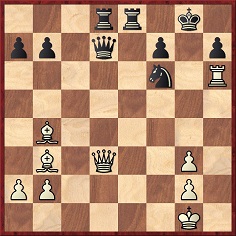
28 Rg6+ Kh8 29 Bc3 hxg6 30 Bxf6+ Kh7 31 Qc4 Qf5 32 Bxd8 (There was a mate in four with 32 Qxf7+.) 32…Re1+ 33 Kh2 Qh5+ 34 Qh4 Resigns.
(2280)

(2280)
Which was the first monograph on Kasparov? Our chronological list in C.N. 2751 began with Garri Kasparov – the Chess Prodigy from Baku by E. Brøndum (Copenhagen, 1980), but Calle Erlandsson (Lund, Sweden) now informs us that when he had the opportunity, during Kasparov’s visit to Lund on 13 December 2003, to have some items signed by the master one of them was 60 partier 1978-80, a duplicated 42-page Swedish booklet (A4 size) issued by the Strömstad Chess Club. Since that booklet’s Foreword was dated ‘November 1980’, it may well be that Brondum’s work had indeed come first, but can anyone put the matter beyond doubt?
(3128)
C.N. 3128 referred to a scarce monograph, published in Sweden in 1980, on Kasparov’s games, and we can think of only one volume of text by Kasparov himself which is difficult to obtain: Politik, Schach und die Grenzen menschlicher Leistungsfähigkeit (Zurich, undated). Fifty pages long, it was published by Bank Hofmann and comprises, in German translation, abridgments of three lectures given by Kasparov in 1999. They were entitled ‘Russia – Stuck with its Past’, ‘Chess, Politics & Computers’ and ‘Limits of Human Performance’.
(3310)
The 67-page Brøndum book was mentioned as follows in C.N. 88:
Many of the 65 games are unannotated, and what prose there is makes use of a quaintly international sort of English. A few crosstables are given, as well as some photographs in which Kasparov exhibits a variety of facial expressions whilst always wearing the same polo-neck sweater.
See also Books about Fischer and Kasparov.
From Avital Pilpel (New York, NY, USA):
‘In 2004, Everyman Chess published Checkmate! My First Chess Book by G. Kasparov. As the title implies, the book is intended for children who are absolute beginners. About half of the 96-page hardback is devoted to the rules of the game and the remainder to “tactical play” (i.e. fork, pin and skewer), common checkmates, and basic opening and endgame principles of the “don’t-move-your-queen-out-early” sort. Every chapter is printed on (glossy) paper of a different color (red, yellow, green, etc.). The book has numerous computer-generated 3-D illustrations.
While this is hardly the first book by a world champion aimed at beginners, it is extremely basic, which makes one wonder to what degree Kasparov was involved in the actual writing. On the other hand, the book contains an introduction by Kasparov (complete with signature), and there is no mention of a co-author, although an “Editor” (Byron Jacobs) is named, and the book’s “Design, typesetting, and illustrations” are credited to Horatio Monteverde. Does anybody know if Kasparov is indeed the author?’
(3814)
See also Chess and Ghostwriting.
An extract from an article by Stephen Fry, ‘Giving the Smyslov Screw a theatrical twist’, which appeared in the Daily Telegraph, 26 October 1990, page 21:
‘My own theory, and I cannot emphasize its worthlessness enough, is that chess is fundamentally a theatrical affair. I first became really interested in the game when I heard about the Smyslov Screw. There was a great Russian world champion, who recently enjoyed something of an Indian summer, called Vassily Smyslov, particularly noted as a master of the endgame. Whenever he moved a piece from one square on to another he had a habit of twisting it, as if screwing it into the surface of the board.
Others might drop their man lightly or bang it aggressively, Smyslov gently screwed it in. The psychological effect of such a move can be devastating. It looks so permanent, so deliberate, so absolutely assured. Kasparov hunches himself over the game, in a brooding, minatory and virile manner that is worth at least three extra pawns.’
(4275)
Not every reader may succeed in identifying the player purportedly depicted in this painting:
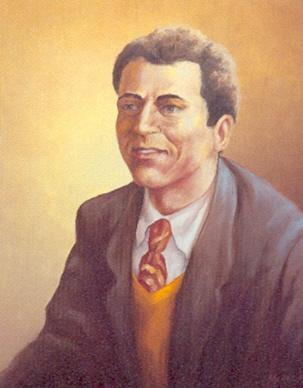
(4282)
The painting, by John McGrew, was intended to depict Garry Kasparov. No reader sent in the right answer.
(4287)
Page vii of One Move and You’re Dead by Erwin Brecher and Leonard Barden (London, 2007) records that Barden ...
‘... was the first to predict in print that Garry Kasparov (then 11) would become world champion and that Nigel Short (then nine) would become Kasparov’s challenger.’
Regarding the Kasparov forecast, we are grateful to the Guardian Research Department for sending us the column in question (The Guardian, 24 February 1975, page 16) and for permission to reproduce it here:
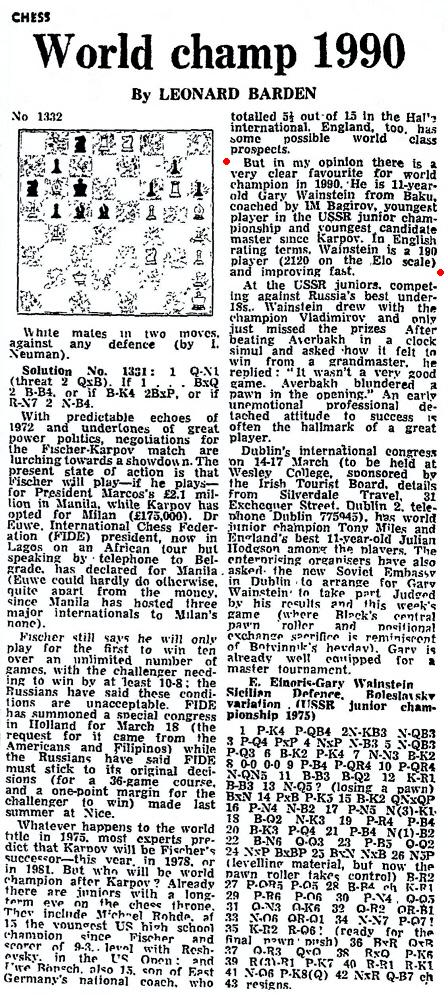
‘But in my opinion there is a very clear favourite for world champion in 1990. He is 11-year-old Gary Wainstein from Baku, coached by IM Bagirov, youngest player in the USSR junior championship and youngest candidate master since Karpov. In English rating terms, Wainstein is a 190 player (2120 on the Elo scale) and improving fast.’
In C.N. 507, after the prediction’s appearance on pages 5-6 of the book on Kasparov Fighting Chess (London, 1983), we described it as ‘an amazing piece of talent-spotting’. Fighting Chess called the passage ‘the first western report’ on Kasparov.
Further to the remarks about English players in the above Guardian column, Leonard Barden (London) informs us:
‘My comment that “England, too, has some possible world class prospects” was a reference to both Julian Hodgson and Nigel Short. It was not until March-April 1975, after Short had performed impressively in Jersey and in a junior event in London, that I rated him ahead of Hodgson, allowing for age, and as a potential rival for Garry Kasparov. At the end of the London event I asked Čenĕk Kottnauer, whose opinion on juniors I regarded highly, to analyse and play a game with Short, and Kottnauer was greatly impressed.
The invitation to the Soviet Embassy for Weinstein to play was on my prompting, my grounds being that he would be nervous on his first journey to the West and that Hodgson could gain a psychological edge for battles to come. Moscow refused.
My forecast in the Guardian of 24 February 1975 was made about 15 months before Botvinnik went into print with his famous remark about the future of chess being in Kasparov’s hands.’
(5783)
Addition on 9 May 2025:
From the Guardian chess column by Leonard Barden, 9 May 2025:
At international level, the boy to watch is Roman Shogdzhiev. The Russian, already world under-eight champion with 11/11 and world under-10 champion with 10/11, achieved his first IM norm last year aged nine, and has just scored his second IM norm at the Baku Open, registering a tournament performance of over 2500. Shogdzhiev is now on track to break the record of Argentina’s “chess Messi” Faustino Oro as the youngest ever international master.
The Garry Kasparov of the 21st century? In 1975, this column forecast that the then unknown 11-year-old Garik Weinstein (later Kasparov) would succeed Anatoly Karpov as world champion by 1990. Now, Shogdzhiev looks the part as the player to restore Russia’s lost chess glories in the next decade.
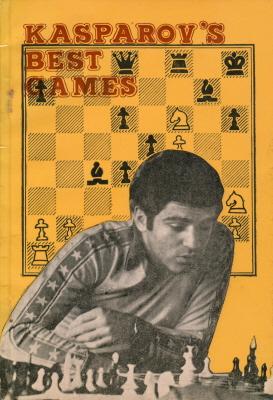
There cannot be many chess books more liberal with typos than Kasparov’s Best Games by K.R. Seshadri (Madras, 1984). The first word of the Preface gives Kasparov’s forename as Carri, and the first two paragraphs have occurrences of Kasperov. Overleaf, the forename becomes Gerry. The annotations, taken from the writings of Kasparov and others, are continually mutilated. Here, from page 46, is part of a note to White’s 15th move in Korchnoi v Kasparov, Lucerne (‘Lucerene’), 1982:
‘Hewever, the problamatic ideal manouvre 21 Nc4! suggested by Yugoslav Grandmaster Kovachevic put an end to the theoratical arguments n favour of White.’
(6042)
Frederick S. Rhine (Park Ridge, IL, USA) draws attention to page 96 of On Top of the Chess World by L. Christiansen, J. Fedorowicz and I. Gurevich (San Francisco, 1995), where Gurevich annotated the 14th match-game between Kasparov and Anand:
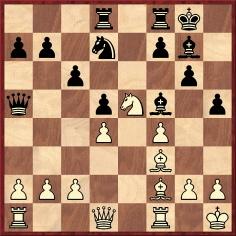
Anand’s 17...Qc7 received this comment by Gurevich:
‘Black could not do without this move, since 17...f6 18 Nd3 Nb6? is bad due to 19 Be1! Qb5 19 [sic] Nc5.’
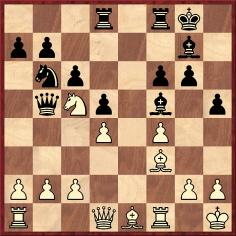
Mr Rhine comments: ‘20...Qxf1 mate would be a strong rejoinder.’
(6280)
On page 26 of the April 2004 Chess Life Larry Evans wrote:
‘“So it’s to be Short and it will be short”, quipped Kasparov upon learning the name of his challenger (who eliminated Anatoly Karpov and then Jan Timman, to reach the top).’
In reality, the famous quip was made by Kasparov during the Manila Olympiad in June 1992, long before the Short v Timman Candidates’ final (which ended on 30 January 1993). From page 462 of Garry Kasparov on Garry Kasparov Part II: 1985-1993 (London, 2013):
‘... journalists had asked me who would win the forthcoming final Candidates match – Timman or Short? – and how my next world championship match would end. To the first question I replied: “It will be Short.” And, laughing, I made the same reply to the second question: “It will be short.” On learning of this from the tournament bulletin, Short took offence ...’
In an interview with Dirk Jan ten Geuzendam (see page 54 of the 5/1992 New in Chess) Short light-heartedly dismissed Kasparov’s remark (which he gave as ‘It will be Short and it will be short’).
(8376)
C.N. 8376 pointed out incorrect information about when Kasparov made his ‘it will be short’ quip: it was in June 1992, i.e. some six months before the Short v Timman Candidates’ final.
Kasparov mentioned that the joke was reported in a bulletin of the Manila Olympiad, held in June 1992. Can a reader kindly forward us a copy?
(9221)
The bulletin (June 1992) of the Manila Olympiad has been provided by Henk Chervet of the Koninklijke Bibliotheek in The Hague:
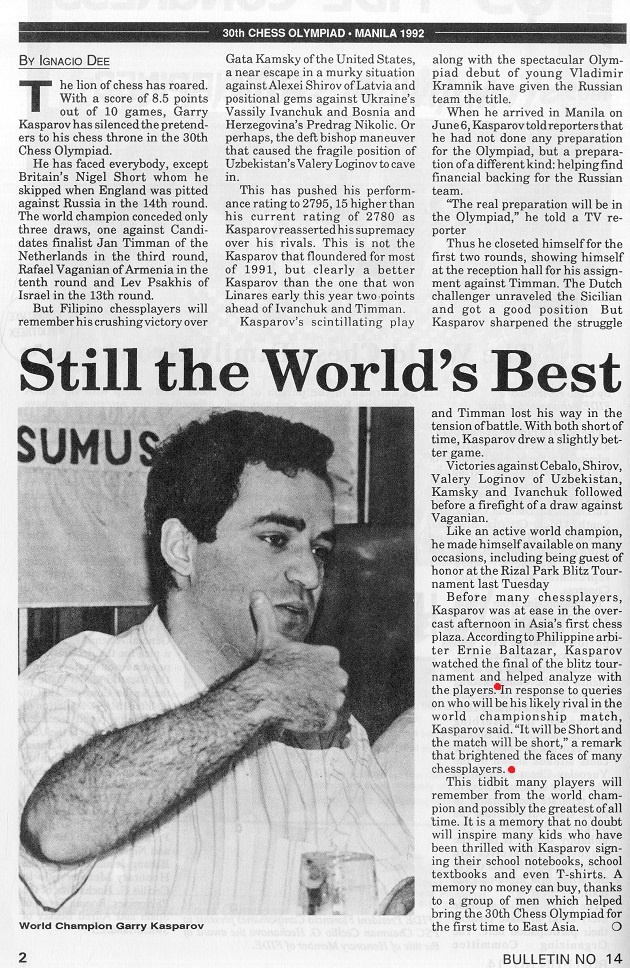
(9251)
Unsurprisingly, chess is seldom referred to in language courses, with the exception of Russian. One manual for beginners even has a text which mentions Karpov:
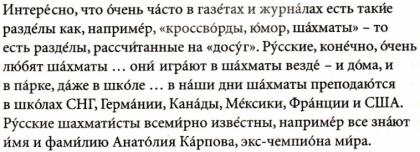
Source: page 170 of Complete Russian by Daphne West (London, 2010). On page 122 of an earlier edition, published under the title Teach Yourself Russian, a source for the passage was given: Sputnik.
A text featuring chess was included on pages 169-171 of The Penguin Russian Reader edited by P.H. Meades (Harmondsworth, 1969). It ended as follows:
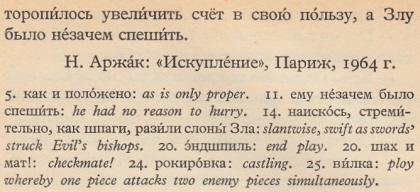
(8684)
An addition to C.N. 8684 concerns pages 123-131 of part four of Читаем без проблем by N.A. Kostiuk (St Petersburg, 2013):
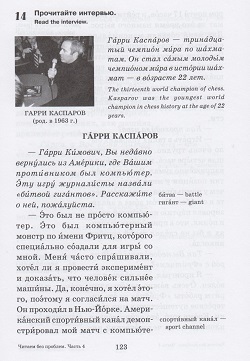
Page 127 specifies the source of the interview: Аргументы и факты, 50/2003 and 3/2004.
(11023)
From page 225 of The Rocket That Fell to Earth: Roger Clemens and the Rage for Baseball Immortality by Jeff Pearlman (New York, 2009):
‘For so much of the season, Clemens came off as baseball’s Garry Kasparov – cold, indifferent, unemotional.’
The quote has been forwarded by Tony Bronzin (Newark, DE, USA), who comments:
‘I can conjure a few adjectives to describe Kasparov, but “cold, indifferent, unemotional”?’
(8791)
We have received two translations of Kasparov’s political articles, Poutine: des Jeux et des geôles (Paris, 2014) and Scacco matto a Putin (Milan, 2014). The back cover of the former book gives the flavour:
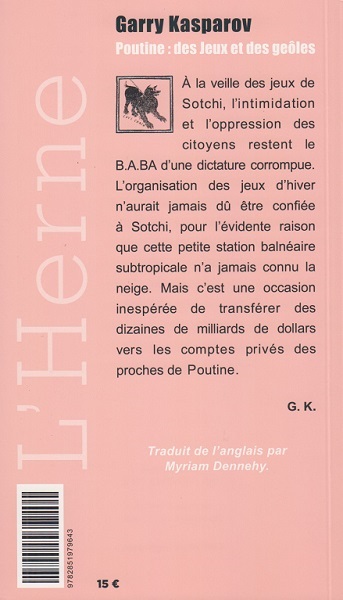
The overwhelming impression gained, as ever, is that the author’s proper place is at the chess board. Among the masters, Kasparov seems the most politically minded and the least politically adept.
The back cover of the Italian translation:
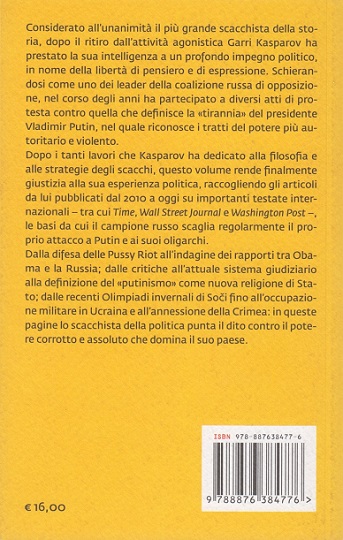
We offer a briefer assessment of Kasparov: Hopeless politician, hapless agitator.
C.N. 1916 quoted some of Garry Kasparov’s replies in an interview published on pages 61-73 of Playboy, November 1989. They included the following on page 70, in response to the question, ‘How about women chess players?’
‘Well, in the past, I have said that there is real chess and women’s chess. Some people don’t like to hear this, but chess does not fit women properly. It’s a fight, you know? A big fight. It’s not for women. Sorry. She’s helpless if she has men’s opposition. I think this is very simple logic. It’s the logic of a fighter, a professional fighter. Women are weaker fighters.
There is also the aspect of creativity in chess. You have to create new ideas. That’s quite difficult, too. Chess is the combination of sport, art and science. In all these fields, you can see men’s superiority. Just compare the sexes in literature, in music or in art. The result is, you know, obvious. Probably the answer is in the genes.’
The interviewer then said: ‘Do you realize that you’re expressing a sexist point of view, and that Western women will be enraged by it?’ Kasparov replied:
‘Yes, but I’m not concerned. I’m sure that women can do many things better than men in many fields. I think it’s wrong to want to be compared all the time, to want to be equal in everything. Men and women are different.’
(9385)
C.N. 10433 quoted from page 268 of Deep Thinking by Garry Kasparov with Mig Greengard (New York, 2017):
‘I won’t hide from the fact that I did make regrettably sexist remarks about women in chess around this time. In that 1989 Playboy interview I said men were better at chess because “women are weaker fighters” and that “probably the answer is in the genes”. The possibility of gender brain differences aside, I find it almost hard to believe I said this considering that my mother is the toughest fighter I know.’
See Chess and Women.
From page 153 of Check Mate and Word Games by Carlos Tortoza (Denver, 2006):
‘In 1993, Garry Kasparov, then champion created Professional Chess Association (PCA) worldwide for the FIDE, and Nigel Shorts for the organization and marketing of the series of games for the worldwide heading.
Kasparov and Short had accused to the FIDE with the professionalism lack and favoritism. Moreover, the two had refused to yield 25% of the prizes for the FIDE. The FIDE removed the heading of Worldwide Champion of Chess of Kasparov and denied the Shorts the right to defy Kasparov.’
Two years later:
‘The PCA finished for leaving to exist due to sponsorship, when the Intel left to subvention the association ...’
(9025)

Inscriptions on the front cover of the 1993 Kasparov v Short match bulletins
On page 11 of the 7/1993 New in Chess, Hans Ree described The Times’ reporting as ‘an embarrassing collection of hype and half-truths’. But what about the outright untruths too? A few examples follow.
The newspaper’s (premature) announcement, by Daniel Johnson on 31 March 1993, that it had secured the Kasparov v Short match asserted that The Times had offered ‘the largest prize fund in the history of chess’. In fact, it was smaller than the purses for Kasparov v Karpov, 1990 and Fischer v Spassky, 1992.
The Times’ frequent references to the closing stages of the 1984-85 Karpov v Kasparov match were flatly false. On 27 February Raymond Keene wrote that ‘Kasparov revived and began to win game after game’. On 1 April Walter Ellis claimed that Campomanes had stopped that match as Kasparov ‘began to move ahead of the “approved” champion, Anatoly Karpov’, while a leading article the same day affirmed that the match was stopped ‘after Kasparov had won several games in a row’.
[Addition on page 271 of Kings, Commoners and Knaves: The misinformation has continued. On page 49 of Man v Machine by Raymond Keene and Byron Jacobs with Tony Buzan, we are told that the match was stopped ‘just as Kasparov had started to win a series of games’.]
General chess history fared no better. On 26 June Raymond Keene wrote that one of Reuben Fine’s triumphs in the 1930s was ‘share of first prize with Capablanca at Nottingham, 1936’; on 21 August his column claimed that Gustav Neumann won a tournament four years after he had died; on 9 September he erred by 30 years regarding the origins of the Marshall Gambit in the Ruy López.
The Times even proved unreliable about itself. On 18 May Ian Murray, after showing total ignorance about the conditions for pre-Second World War world title matches, blundered about the identity of the newspaper’s own chess correspondent in the 1930s.
Throughout the Kasparov v Short match, The Times claimed to be publishing annotations by Short, but page 224 of The Inner Game by Dominic Lawson, a close friend of Short’s, reveals: ‘Nigel Short, however, never once bothered to speak to the Times man about the games the day after they were played. Instead, he would delegate one of his seconds, usually Jon Speelman, to give the newspaper some analysis to satisfy its readers, and it was this which would duly appear, masquerading as the unintermediated voice of Nigel Short.’
Incidentally, the same book reports (page 146) that during the match Times staff ‘privately told Short that they would pay for any grandmaster in the world to be flown to London to help him recover from his four-game deficit. What Kasparov would have thought, let alone said, had he discovered that the organisers of the match were prepared financially to back one of the participants against the other – him – defies exact prediction. It would certainly have been a spectacular Azerbaizhani outburst.’
(Letter from us on pages 4-5 of the 1/1994 New in Chess)
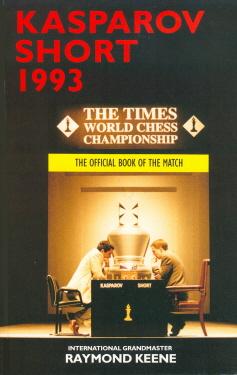
With regard to the interview in your 94/8 issue, Mr Bob Rice’s knowledge of chess and/or sense of fairness may be measured by his assertion on page 9 of the Batsford book on the 1993 Kasparov v Short match:
‘Although the World Championship matches have been arranged by many different organizations, the lineage of the 13 Champions has been recognized by all, including the World Chess Federation (FIDE), a group of national amateur bodies that arranged the last several matches.’
‘Last several’ means ‘last seventeen’.
(Letter from us on pages 8-9 of the 1/1995 New in Chess)
Concerning Kasparov’s tenure of the world title, below are the last two names on a list of challengers on page 279 of Keene On Chess by Raymond Keene (New York, 1999):

The respective dates should obviously be 1993 and 1995.
Mr Keene, though, stuck to his guns. From page 280 of his Complete Book of Beginning Chess (New York, 2003):

(8434)
Steve Wrinn (Homer, NY, USA) draws attention to a passage on page 404 of Garry Kasparov on Garry Kasparov Part III: 1993-2005 (London, 2014) regarding the game Leko v Kasparov, Linares, 2003:
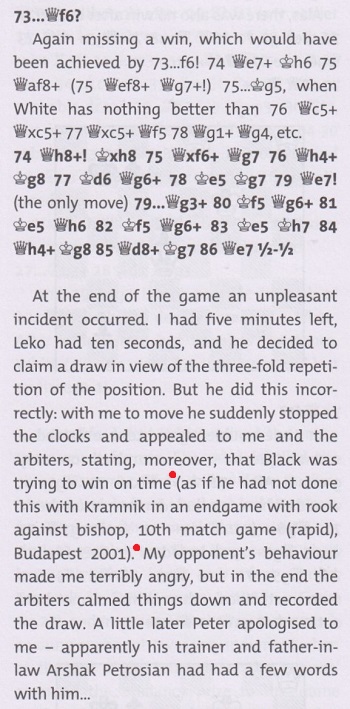
Our correspondent remarks:
‘In the rapid game referred to by Kasparov it was Kramnik who had the rook against Leko’s bishop. Kramnik ultimately won on time at the 133rd move, and his decision to play on in a theoretically drawn position elicited various comments. For example, in the Los Angeles Times, 14 January 2001 Jack Peters wrote:
“The players revealed opposing attitudes to rapid chess in the time scrambles at the end of the seventh and tenth games. In both cases, Kramnik had a nominal advantage that Leko neutralized easily. In the seventh game, Kramnik, with only five seconds remaining, offered a draw to Leko, who had 23 seconds left. Leko graciously accepted. In the tenth game, Kramnik had the edge on the clock and kept playing a drawn position until Leko ran out of time.”’
(9273)
Below is the first section of an article ‘Pure hatred as Capitalist King meets Party Pawn’ by Andrew Stephen on page 13 of the Observer, 7 October 1990:

There were many similar articles in the 1980s and 1990s. They left no doubt as to the writer’s sympathies, though plenty as to his credentials. Little or nothing is sourced, and the reader cannot know where the information comes from, or judge how trustworthy it is. A single article such as Andrew Stephen’s could provide fodder for a dozen C.N. items soliciting corroboration of the various quotes and assertions.
As regards the rivalry (‘pure hatred’) between Kasparov and Karpov, to what extent have journalists been duped? A remark from page 213 of Karpov on Karpov (New York, 1991), a book referred to in Karpov’s Writings, is worth recalling:
‘Every match is preceded by scandalous situations. Some arise spontaneously, others are planned, but in general a match never comes off without them. Kasparov and I also tried to uphold the ancient tradition and toss the journalists some choice morsels.’
(9345)
On page 184 of the above-mentioned book Karpov wrote:
‘But Kasparov and I have nothing in common. We were formed in different eras, I in the year of social renaissance and the emancipation of the populace’s soul, and he in a time of stagnation. I came from the simple people and for a long time I remained one of them. He was singled out in childhood; elitism became an essential part of his world. For me chess was the end, for him it has merely been the means.’
Garry Kasparov’s track-record as a writer may generously be called patchy. The early triumph of The Test of Time (Oxford, 1986) was followed by the calamitous Child of Change (London, 1987). Kasparov Against the World, co-written with Daniel King (New York, 2000), received warm plaudits, but in Kasparov’s Predecessors series the first volume (London, 2003) was particularly shameful for its lack of historical rigour. His indifference to the game’s lore was highlighted in How Life Imitates Chess (New York and London, 2007).
Written just after he retired from serious chess play, our article Reflections on Garry Kasparov suggests certain reasons (some book-related, including his lamentable choice of associates) for the decline in his general reputation in the chess world, and since 2005 Kasparov’s focus has been on Russian and international politics. That has now resulted in Winter is Coming by Garry Kasparov with Mig Greengard (London, 2015), a 290-page work subtitled ‘Why Vladimir Putin and the enemies of the free world must be stopped’.
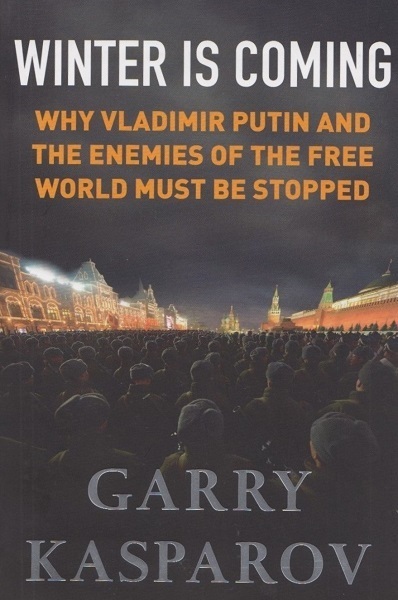
On page 286 some of the index entries for ‘Putin, Vladimir’ convey the book’s thrust: ‘aggressive actions summary (2008)’; ‘anti-democratic actions summaries’; ‘background/KGB and’; ‘comparisons to other dictators’; ‘corruption and’; ‘Hitler comparisons and’; ‘mafia comparisons and’; ‘people’s unimportance to’; ‘popularity myth’; ‘recommendations on ending his regime’.
Fortunately, the book has little if anything in the two areas of chess – history and politics – which have caused so much damage to Kasparov’s standing through his predisposition towards inaccurate and unsubstantiated statements ...Nothing would induce us to comment on Kasparov’s political beliefs or on how they are set out and backed up in his book. On the purely technical question of prose quality, we gladly observe that Winter is Coming is the best book that Kasparov has produced.
(9545)
Following information received from Miquel Artigas (Sabadell, Spain), we have acquired Chamo-me ... Garry Kasparov (Lisbon, 2011), as well as the translations into Spanish and Catalan, Me llamo ... Garri Kasparov (Badalona, 2013) and Em dic ... Garri Kasparov (Badalona, 2013).
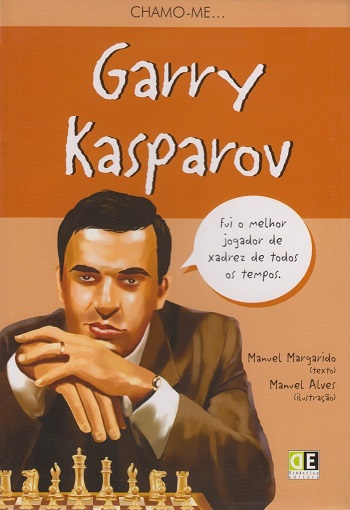
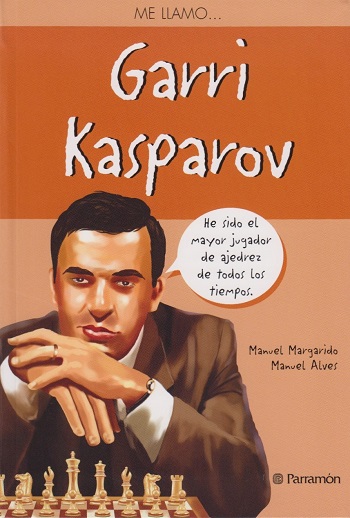
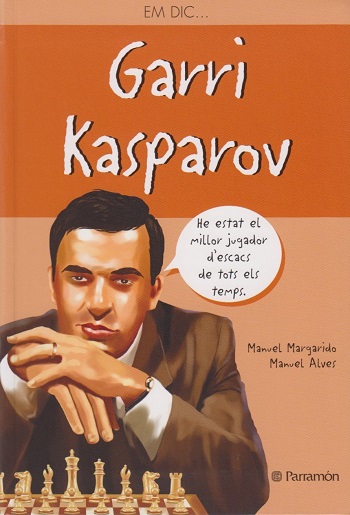
Intended for children aged nine and over, the 64-page book was written by Manuel Margarido and illustrated by Manuel Alves. It is part of an extensive series of imaginary autobiographies:
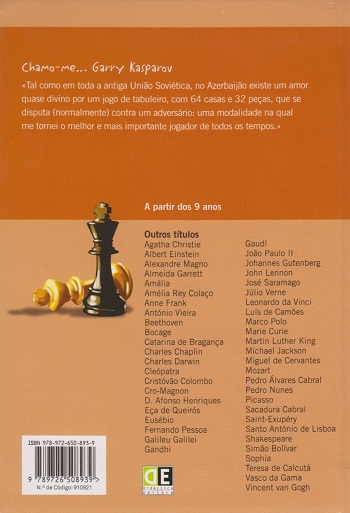
The principal sources for the Kasparov text are loose talk from the Internet (including, on pages 15-16, ‘it is calculated that more than 600 million people throughout the world play chess’) and his own books, which are sometimes no less loose. The section on ‘My books’ refers to the atrocious (our word, and not Margarido’s or Kasparov’s) Child of Change and to the first volume of My Great Predecessors. The latter book, abysmal in terms of history and scholarship, is described on page 47 as merely containing ‘some errors, later corrected’. Would that they had been.
Kasparov’s political/agitatorial activities are covered too, as shown by pages 54-55:
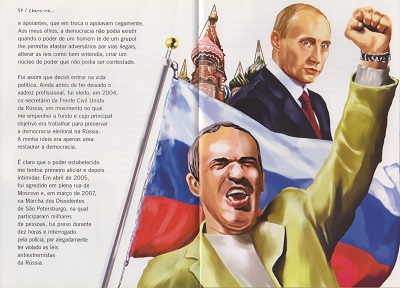
The front and back covers have Kasparov affirming that he was the best chessplayer of all time, whereas the book’s text puts slightly more cautious words in his mouth. From page 44:
‘Para muitos, como te disse, fui o melhor jogador de xadrez de todos os tempos. Já me conheces e sabes que não vou negar essa opinião.’
Many respectable authorities have called Kasparov the greatest player in the game’s history, but how close has he himself ever come to making such a claim?
(9839)
Adam Ponting (Petersham, Australia) notes a ChessBase article dated 5 April 2005 in which one of the questions posed to Kasparov by Mig Greengard and Dylan Loeb McClain, ‘Where would you rank yourself all-time?’, was answered as follows:
‘I don’t like this question in general, it’s too subjective. By most standards, number one because of the length of my high performance and the strength of the opposition. The greatest gap between the number one and the rest was Bobby Fischer in 1972, but that was just one or two years and then came Karpov. I was able to keep up with the new generation and beat them. I was able to stay on the cutting edge, stay on top of the ranking for 20 years. I would say that entitles me to be number one.’
(9852)
From Bruce Monson (Colorado Springs, CO, USA):
‘Even though Kasparov did not show up for the start of game one in Pasadena in 1983, Korchnoi was there and actually made a move, 1 d4. Kasparov was forfeited, of course, but ultimately this did not count.
I have not seen any photographs of Korchnoi sitting at the board across from Kasparov’s empty chair. Do you know of any?’
The Candidates’ Semi-Final match between Kasparov and Korchnoi was due to begin in Pasadena on 6 August 1983. Below is a report on page A2 of the following day’s edition of the San Bernardino County Sun:
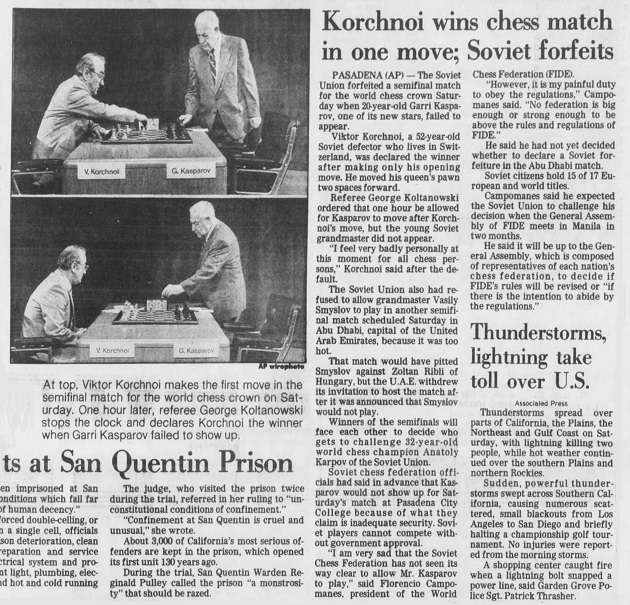
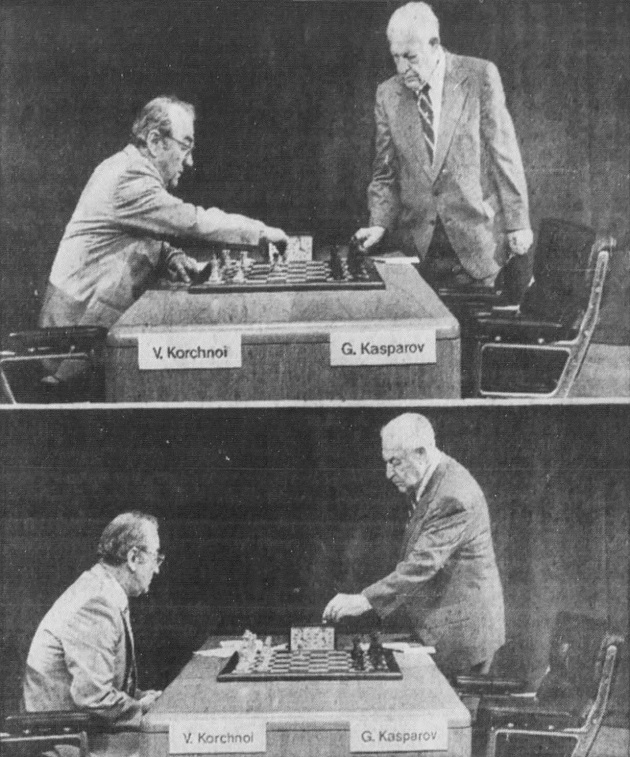
(10004)
Bruce Monson notes that two photographs accompanied a report in the Los Angeles Times, 7 August 1983, pages 1 and 7. Better copies are sought.
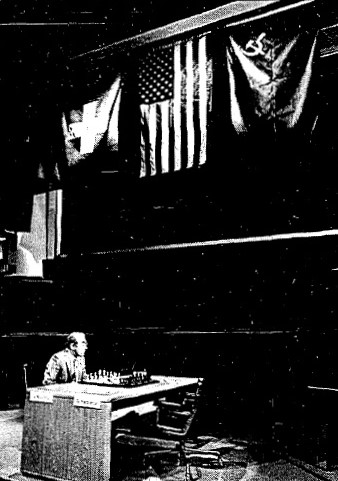
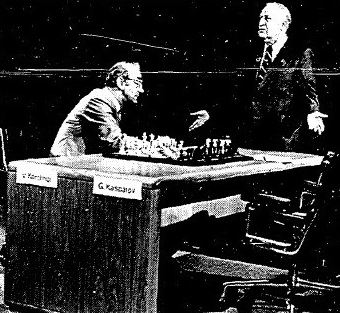
(10063)
This block of nine postage stamps (North Korea/‘Democratic People’s Republic of Korea’, with the dates 1984, 1985 and 1986) is a curiosity in our collection:
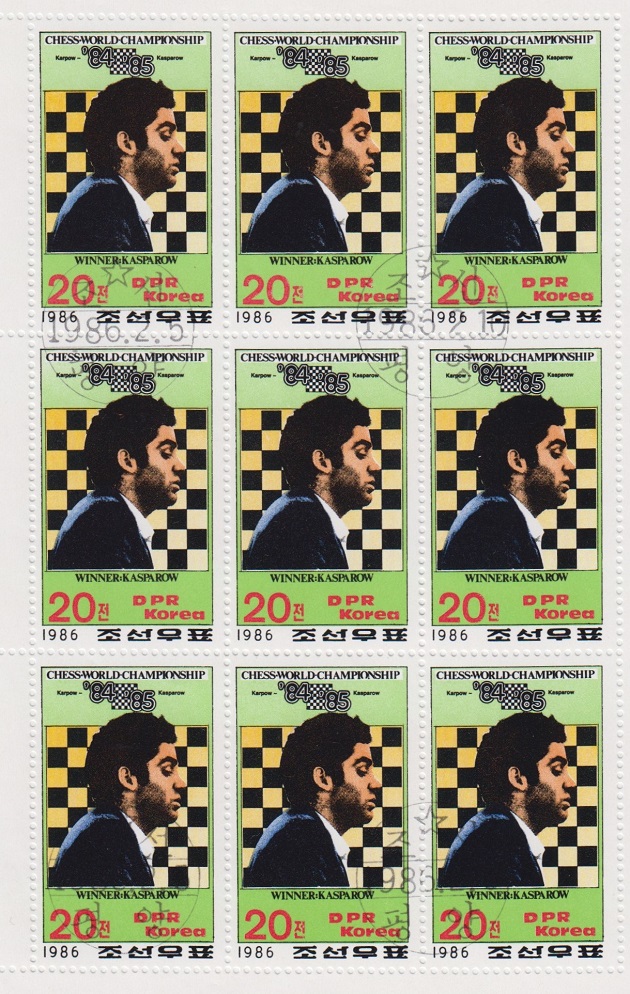
(10389)
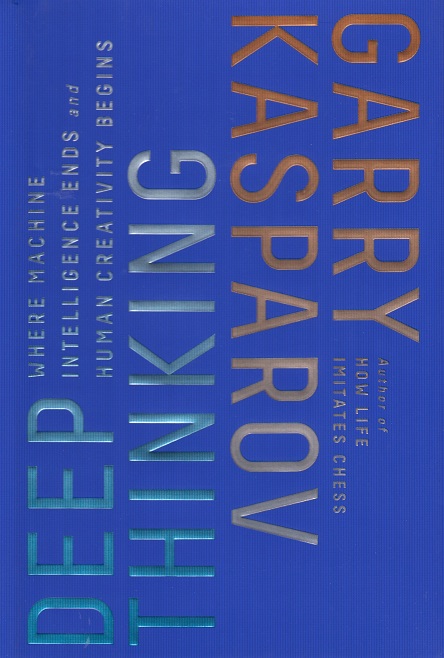
From Deep Thinking by Garry Kasparov with Mig Greengard (New York, 2017) we quote a selection of passages which focus on autobiographical matters and chess lore (rather than computers, the central theme of the book):
I want to clear that up right at the start. I hate losing. I hated losing bad games and I hated losing good ones. I hated losing to weak players and I hated losing to world champions.
I have had sleepless nights after losses. I have had angry outbursts at award ceremonies after a bad defeat. I have been annoyed to discover that I missed a good move in a game I lost 20 years ago when analyzing it for this book.
I hate to lose, and not just at chess. I hate to lose at trivia games. I hate to lose at card games. (My complete lack of a poker face is why I rarely play them.)
Being a sore loser is not the attribute I’m most proud of, nor am I ashamed of it. To be the best in any competitive endeavor you have to hate losing more than you are afraid of it.’ (Page 113)
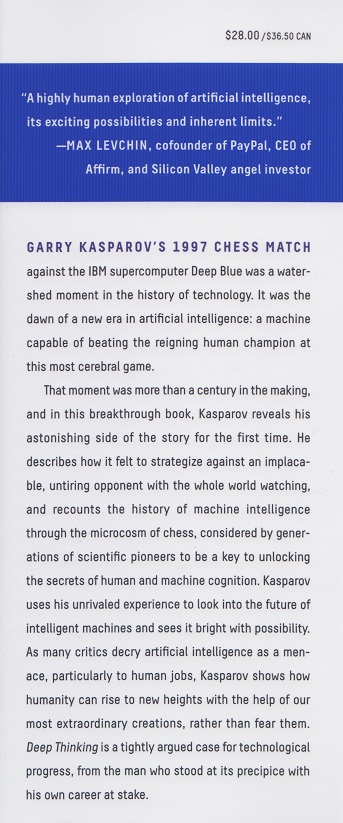
The inside dust-jacket of Deep Thinking
From page 92:
‘It was hard to not recall the retort attributed to Bobby Fischer when an eager fan pressed him after a difficult win. “Nice game, Bobby!” Fischer answered, “How would you know?”’
The corresponding endnote on page 267:
‘I was told this story in Buenos Aires, Argentina, and have no way to know if it’s true. But it definitely sounds like something Fischer might say. It is also bitingly insightful, as few fans would have any idea of the quality of a world champion’s game without expert commentary. Today it’s quite different, when everyone has a super-strong engine at his disposal and feels empowered to scoff at the champion’s mistakes as if they’d found them themselves.’
On the Fischer matter we add that in the late 1980s Stewart Reuben managed to become a BCM columnist and that on page 338 of the August 1989 issue he wrote this ‘once’ story:
‘Jimmy Adams once said to Fischer in Monaco, “Gee, Mr Fischer, that was a beautiful game you just played!” Bobby’s reply, “How would you know?”’
On page 447 of the October 1989 BCM Reuben apologized to Adams:
‘He tells me this never took place and that the only words that ever passed between them were “Excuse me”.’
Kasparov’s observation about people pointing out a champion’s mistakes ‘as if they’d found them themselves’ makes us wonder how often he has been the victim of a common piece of annotational malpractice: in a book or article a champion (e.g. Capablanca or Alekhine) presents analysis which is an improvement on his actual play, and a subsequent annotator (e.g. Panov or Kotov) reproduces the same variations anonymously, as if they were his own discovery. There cannot be many areas of human activity where a critic has the opportunity to act that way.
The final acknowledgement on page 262 of Deep Thinking is to ‘My collaborator of nearly 19 years, Mig Greengard, whose former lives in programming and chess made him even more indispensable than usual on this project’. The book’s fine prose and general editing underscore how poorly Kasparov and Everyman Chess served each other. (One small correction, concerning page 81: Lasker’s Common Sense in Chess was dated 1896, and not 1910.)
Kasparov’s Deep Thinking is an absorbing, often brilliant, book which no chess lover should miss.
(10433)
From Copying (acknowledgement: keene-watchers):
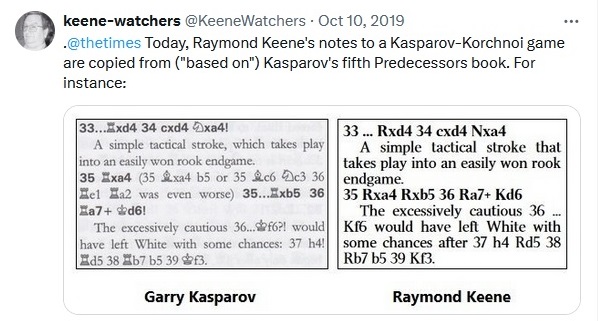
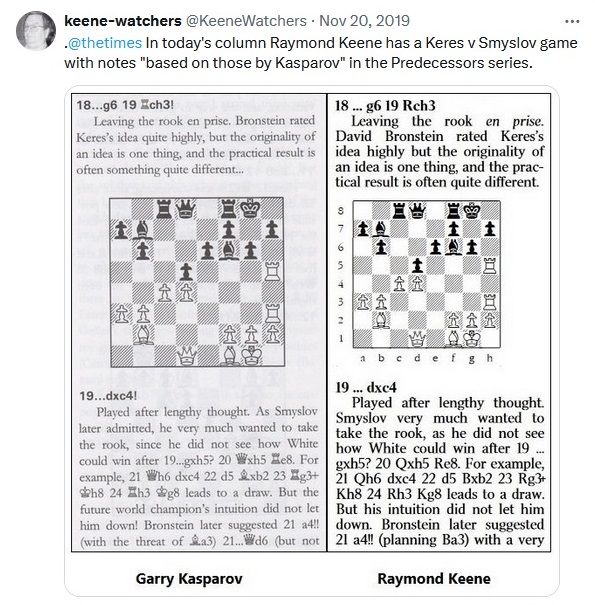
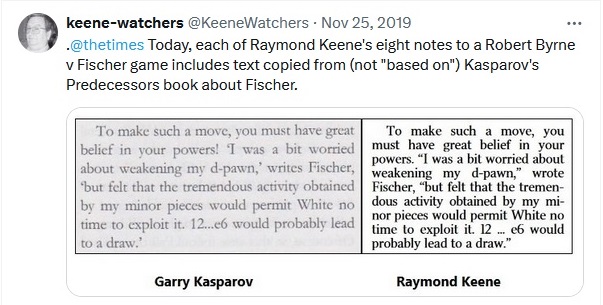
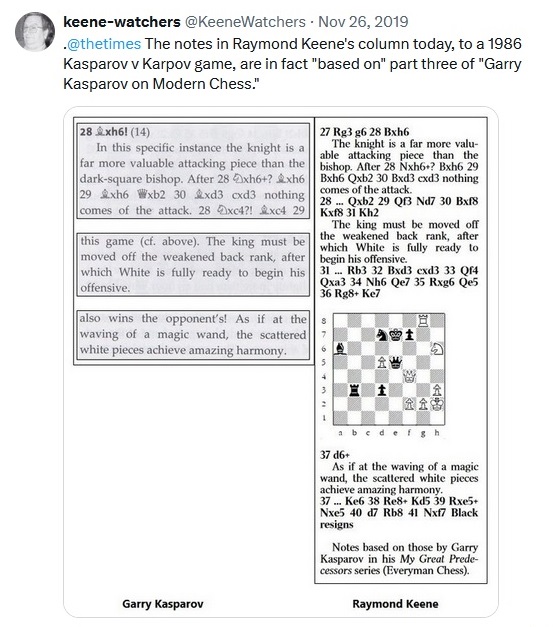
For further information, see our feature article on Raymond Keene, OBE, Ctrl+C, Ctrl+V).
An unfathomable claim about FIDE on pages 288-289 of Who Was The Strongest? by Raymond Keene, Nathan Divinsky and Jeff Sonas (Aylesbeare, 2006):
‘Three years later [in 1993] Kasparov annihilated Nigel Short in a match that was held outside the auspices of FIDE, the World Chess Federation, which had shown itself increasingly incompetent to handle events at the highest level. FIDE soldiered gamely on with its own championship, much as it did before the death of Alekhine in 1946, but FIDE always had to make do without the world’s top two players at any given time.’
(11167)
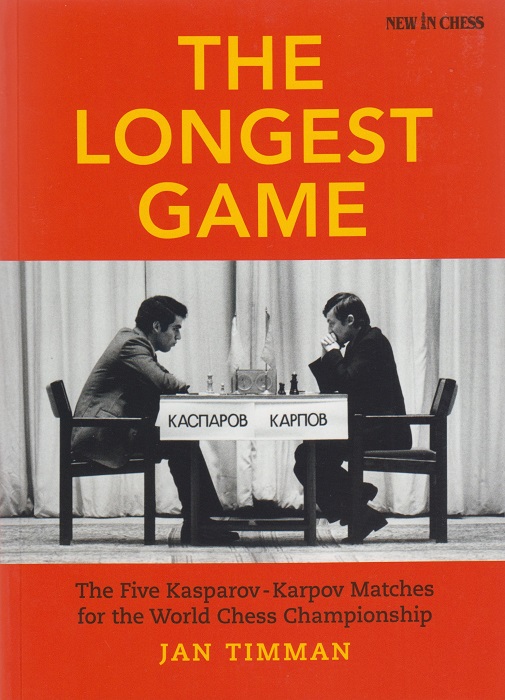
In the context of the 1986 world title match, on page 144 of The Longest Game by Jan Timman (Alkmaar, 2019) there is no mincing of words about Bjelica:
‘Karpov did not have a clear delegation leader, but he did have a press attaché: the Yugoslav Dmitri Bjelica. That was a strange choice, as Bjelica was known as a gutter journalist who wrote books that were full of printing errors and plagiarisms.’
(11226)
A comment of ours in InstantFischer (‘Kasparov has trouble not contradicting himself over what he said last Tuesday’) was quoted by Olimpiu G. Urcan on Twitter on 23 February 2021, accompanied by a clip from the 1937 Laurel and Hardy film Way Out West in which, replying to ‘What did he die of?’, Stan Laurel said, ‘I think he died of a Tuesday ...’ A question of language arises: why, in such cases, is Tuesday the most effective day to mention?
We have put the matter to Stephen Fry, who replies:
‘No question that Tuesday is the funniest day. Always has been. Though Douglas Adams came up with that line “This must be Thursday. I never could get the hang of Thursdays” which shows Thursday comes in a good second. Monday wouldn’t work because there’s a reason why “I don’t like Mondays” as Bob Geldof sang. Wednesday is just too much of a mouthful to zing. Friday is too associated with payday and the end of the week, and the other two days are reserved for weekend properties. So perhaps it’s more a process of elimination … I wonder if any continental languages have equivalents. Is Mittwoch as funny as Dienstag?
Tuesday doesn’t follow the “hard C” rule (see the film The Sunshine Boys for a wonderful scene involving hard Cs).
Noël Coward often pondered why some place names are funny, and even claimed that in America funny place names are only funny because the word itself is inherently amusing – “Schenectady” “Kalamazoo” “Albuquerque” – whereas the British find certain places funny for less obvious reasons: “Neasden” and “Purley” might elicit a laugh, whereas “Hendon” and “Portsmouth” for example wouldn’t. Hugh [Laurie] and I got much mileage out of Uttoxeter, mileage that Exeter or Huddersfield would never have offered …’
(11857)
The chessplaying activities of Rachel Reeves (born 1979) have been widely documented. This photograph, showing her with Garry Kasparov, is reproduced with the permission of the archive of PA Images:

In the United Kingdom she was appointed Chancellor of the Exchequer by Sir Keir Starmer on 5 July 2024.
The simultaneous display took place at the House of Lords, London on 8 December 2014.
See too Articles about Garry Kasparov. Footage of the display is available online; it includes interviews with Kasparov and with Jesse Norman (the Conservative MP for Hereford and South Herefordshire).
Much writing on chess history is wishful thinking or name-dropping, but careful authors sidestep the trap of what we propose to call ‘figurehead romanticism’. This includes, for example, claims or assumptions that most of the contents of Lasker’s Chess Magazine and Capablanca-Magazine were written by Lasker and Capablanca themselves. (The case of the International Chess Magazine is different, since Steinitz specified that it was largely a solo enterprise.)
A similar practice was mentioned in C.N. 8827: attributing a book by Tartakower and du Mont to Tartakower only. When there is assisted authorship (such as Kasparov books involving Donald Trelford or Mig Greengard, both of whom receive a ‘with’ credit), some writers need no second bidding to prefer without; they mention Kasparov alone. We can see a case for that in brief bibliographies, but not in reviews or discussions of the book.
(12043)
Tony Bronzin (Newark, DE, USA) writes regarding Garry Kasparov on Modern Chess Part Four: Kasparov vs Karpov 1988-2009 (London, 2010):
‘I wanted to read Kasparov’s version of the behind-the-scenes happenings of the 1994 Moscow Olympiad, delineated so well in Inside Chess and barely touched upon in Chess Life. Since Kasparov devoted multiple pages to why the 1983 Pasadena match with Korchnoi did not take place and 30 pages to his version of what happened after game 48 of the first match with Karpov, situations where at least a case can be made that he was wronged, surely Kasparov would have at least said something about the 1994 Olympiad and why Karpov was not allowed to field a second Russian team. Not a peep ...’
We are grateful to Yasser Seirawan (St Louis, MO, USA) for permission to show the coverage (nine pages) in the 1/1995 issue of Inside Chess.
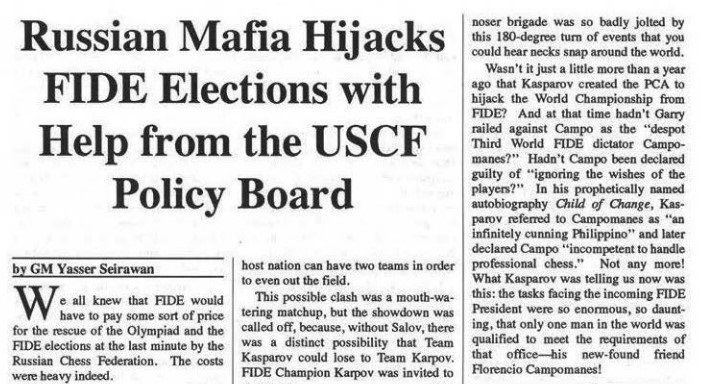
(12151)
To the Chess Notes main page.
To the Archives for other feature articles.
Copyright: Edward Winter. All rights reserved.